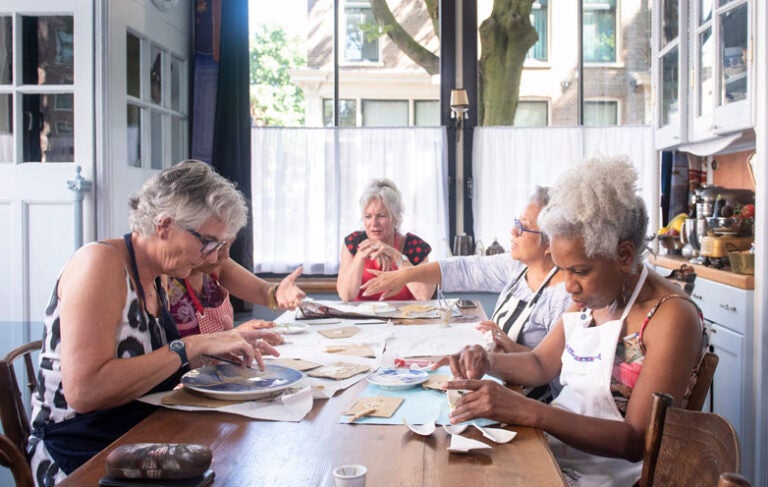Retirees often hear that one of the best ways to make friends and find fulfillment in retirement is to connect with people by joining a club. But what if there isn’t a group that piques your interest in your area? Do what retired nurse Donna Brown did: start one.
After Brown and her husband moved to a small, rural community in Arizona, she couldn’t find many organized activities that spoke to her. Looking for a way to connect with people while enjoying one of her favorite pastimes, Brown asked her yoga students if they’d be interested in joining a hiking club. Some were, so she started one. Here are tips from Brown and others who have done it to help you start a club.
Look for Partners
When musician and retired early childhood educator Jan Barlow started her first ukulele club, she collaborated with her local public library. Barlow provided structure and musical instruction; the library offered meeting space and loaned out ukuleles and music books. A few years later, a neighboring senior center with a similar group recruited Barlow to lead and expand its club, the Blackstone Valley Strummers.
“Collaborating with a partner like a library or senior center doubles your marketing reach. Both are about building community, and a club is a natural community builder, so it helps them meet their goals, too,” says Barlow, who now focuses her time on the senior center strummers.
David Siegel, CEO of Meetup, a social media platform for hosting and organizing in-person and virtual activities that include clubs, recommends recruiting a co-organizer, too. “When surveyed, 68% of Meetup organizers who felt their groups were successful said they have at least one other co-organizer,” says Siegel, who is also host of the platform’s “Keep Connected” podcast.
Set and Maintain a Consistent Meeting Schedule
Whether you meet weekly or monthly, having a set, predictable schedule makes it easier for people to plan to attend and communicates stability to current and potential members. “Hosting recurring events displays dedication and a sense of constancy, telling your members that you’re here for them for the long haul – not just once,” says Siegel.
Brown’s hiking club meets every Wednesday between 8 and 9 a.m. at their hike’s location, with the exact time determined by driving distance to the trailhead. Barlow’s ukulele players gather at the senior center from 10 to 11:30 on Wednesday mornings but often linger long after. A side benefit of this consistency, she says, is that members notice when another is absent. “If a regular member doesn’t show up, someone will check in with them. We’ve built a real community with this group,” says Barlow.
Make it Easy for People to Participate
“Eliminate any roadblocks that your members might have to attend your event,” advises Siegel. He recommends providing directions to the meeting location as well as instructions on where to park. Include on-site signage when meeting in a public place so potential members can quickly identify your group, too, he says.
To help with retention, Barlow gives every new member a welcome packet that includes a letter assuring them that there are no experience requirements, the meeting schedule, a music book, and a chord chart – “Anything that makes it easy for them to continue,” she says.
Solicit and Accept Feedback
Member feedback might lead to a new meeting location, schedule, or other unexpected but positive changes. “I thought that because I started the club, I would be the leader, yet I soon learned that I would need to be flexible and let others take the lead in deciding where to hike from week to week. In the long run, sharing decision-making takes letting go and going with the flow, but it helps the club grow,” says Brown.
See the Potential
There are no age limits for club organizers, especially when the goal is companionship. When Denise Leleux’s 94-year-old mother, Ann Laguens, moved from her Colorado home to an assisted living center near Leleux in North Carolina, Laguens looked for a way to make new friends around a shared interest. After some informal research that involved chatting up her neighbors, she started a tea club. With almost 20 members now and support from the activities staff, the group sips from Laguens’s tea cup collection while enjoying a craft or activity.
“She’s helped the activities staff, decades her juniors, understand what’s important to people of her generation,” Lelux says. For her mother, she adds, it was finding a sense of purpose.
For more tips to help you plan, organize, and start a club, read Meetup’s guide to starting a group.
Seniority is published by Finance of America Reverse LLC. The views expressed in this publication are those of the author alone and do not necessarily reflect the views and opinions of Finance of America Companies. This article is intended for general informational and educational purposes only and should not be construed as financial or tax advice. For more information about whether a reverse mortgage may be right for you, you should consult an independent financial advisor. For tax advice, please consult a tax professional.




